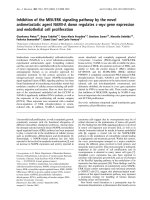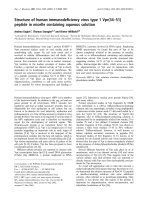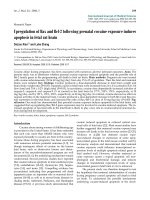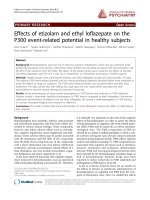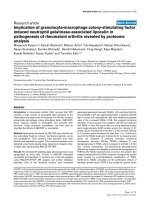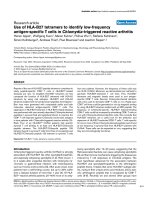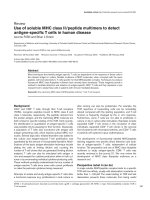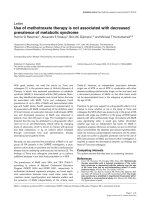Báo cáo y học: "Use of WHO clinical stage for assessing patient eligibility to antiretroviral therapy in a routine health service setting in Jinja, Uganda" pdf
Bạn đang xem bản rút gọn của tài liệu. Xem và tải ngay bản đầy đủ của tài liệu tại đây (205.4 KB, 4 trang )
BioMed Central
Page 1 of 4
(page number not for citation purposes)
AIDS Research and Therapy
Open Access
Short report
Use of WHO clinical stage for assessing patient eligibility to
antiretroviral therapy in a routine health service setting in Jinja,
Uganda
Shabbar Jaffar*
1
, Josephine Birungi
2
, Heiner Grosskurth
3
, Barbara Amuron
3
,
Geoffrey Namara
3
, Christine Nabiryo
2
and Alex Coutinho
2
Address:
1
Department of Epidemiology and Population Health, London School of Hygiene and Tropical Medicine, Keppel Street, London WC1E
7HT, UK,
2
The AIDS Support Organisation, Old Mulago Complex, PO Box 10443, Kampala, Uganda and
3
Medical Research Council/Uganda Virus
Research Institute (MRC/UVRI) Uganda Research Unit on AIDS, P.O. Box 49, Entebbe, Uganda
Email: Shabbar Jaffar* - ; Josephine Birungi - ;
Heiner Grosskurth - ; Barbara Amuron - ;
Geoffrey Namara - ; Christine Nabiryo - ; Alex Coutinho -
* Corresponding author
Abstract
In a routine service delivery setting in Uganda, we assessed the ability of the WHO clinical stage to
accurately identify HIV-infected patients in whom antiretroviral therapy should be started.
Among 4302 subjects screened for ART, the sensitivity and specificity (95% CI) of WHO stage III,
IV against a CD4 count < 200 × 10
6
/l were 52% (50, 54%) and 68% (66, 70%) respectively. Plasma
viral load was tested in a subset of 1453 subjects in whom ART was initiated. Among 938 subjects
with plasma viral load of 100,000 copies or more, 391 (42%, 95% CI 39, 45%) were at WHO stage
I or II.
In this setting, a large number of individuals could have been denied access to antiretroviral therapy
if eligibility to ART was assessed on the basis of WHO clinical stage. There is an urgent need for
greater CD4 count testing and evaluation of the utility of plasma viral load prior to initiation of ART
to accompany the roll-out of ART.
Introduction
In developed countries, CD4 count and plasma viral load
testing are essential for monitoring HIV-infected subjects
and for assessing when antiretroviral therapy (ART)
should be initiated [1]. ART is being scaled-up in Africa
and elsewhere. Many settings do not have the resources to
test CD4 counts and plasma viral load and in these areas,
a patient's HIV stage is assessed on the basis of clinical cri-
teria alone, using the World Health Organisation (WHO)
HIV clinical staging. Those at WHO stage III or IV can be
eligible for ART (provided that they also satisfy psychoso-
cial and other criteria) [2,3].
There are limited data on how well the WHO HIV clinical
stage criteria identifies people correctly for ART. The WHO
clinical stage was associated with survival and biological
outcomes, done in the pre-ART era [4-6]. A hospital-based
study conducted in Cambodia reported limited added
value of using CD4 count in addition to the WHO HIV
clinical staging when assessing patients for ART but the
Published: 28 February 2008
AIDS Research and Therapy 2008, 5:4 doi:10.1186/1742-6405-5-4
Received: 29 October 2007
Accepted: 28 February 2008
This article is available from: />© 2008 Jaffar et al; licensee BioMed Central Ltd.
This is an Open Access article distributed under the terms of the Creative Commons Attribution License ( />),
which permits unrestricted use, distribution, and reproduction in any medium, provided the original work is properly cited.
AIDS Research and Therapy 2008, 5:4 />Page 2 of 4
(page number not for citation purposes)
study was retrospective and comprised a sick group of
patients [7]. More recently, a study conducted in Rakai,
Uganda, showed that 49% of patients with CD4 count
<200 were classified as WHO stage I or II while 12% who
had stage III or IV also had CD4 count >200, suggesting
that large numbers in need of treatment would not be
considered on the basis of clinical staging [8]. The Rakai
study used physicians to stage patients, working in a
research setting. The accuracy of the WHO clinical stage
criteria are unknown in a normal health service delivery
setting, where training and clinical support of clinical staff
can vary and the time pressures are great. There have been
no studies published examining the importance of testing
plasma viral load for assessing patients for ART eligibility
in Africa.
We have screened and initiated ART in a large number of
subjects in a normal health service delivery setting, and
here we compare the different criteria for determining
ART eligibility.
Methods
The study was based at The AIDS Support Organisation
(TASO) clinic in Jinja, SE Uganda. The setting has been
described previously [9,10]. In brief, TASO is a large indig-
enous non-governmental organisation which provides
care and counselling for HIV-infected persons in the coun-
try. The organisation has 11 large centres scattered over
the country and has currently in excess of 10,000 subjects
on ART. TASO treatment schedules follow Ministry of
Health guidelines and clinical staff have similar qualifica-
tions and experience as those of government. TASO has a
clinical centre in Jinja town located in the grounds of Jinja
Hospital and is the largest provider of ART in the area.
In September, 2004, TASO began providing ART as part of
HIV care. Registered clients were asked to come forward
for screening. Eligibility for ART was assessed over 3 visits,
usually scheduled over 4–6 weeks. At the first visit,
patients were examined clinically by a physician and CD4
count was tested. Most physicians were medical officers
with 1–2 years experience post-qualification. Clinical cri-
teria for receiving ART were CD4 count below 200 × 10
6
cells/l or advanced WHO stage III (chronic fever of
unknown origin, chronic diarrhoea of unknown origin,
oral hairy leukoplakia and pyomyositis) or stage IV. From
February 2005, all TASO clients starting ART were invited
to join a pragmatic effectiveness trial evaluating two dif-
ferent strategies of ART delivery (home-based versus facil-
ity-based). The trial was integrated into routine health
service delivery [9,10]. Clinical management of trial par-
ticipants was done by TASO staff and was identical to that
in non-trial participants. Trial subjects were asked for 5 ml
of blood, just prior to starting ART, in order to test plasma
RNA viral load. This testing was done for research pur-
poses in batches and the results were not provided to
patients or clinicians unless either requested [9]. The
TASO ART programme reached capacity and was closed to
new patients in December 2006.
Blood samples for CD4 counting were delivered to the
laboratory about 100 km southwest of the clinic within 36
hours of collection. Testing was done using the BD FACS
Calibur, Multitest™ method (Beckton-Dickenson, San
Carlos, CA). Samples for plasma viral load testing were
processed and stored at the trial site within 2 hours of col-
lection. They were transported to the laboratory and
tested using the HIV-1 RNA 3.0 Assay (bDNA) (Bayer AG).
The study was approved by the ethics committees of
Uganda Virus Research Institute and the London School
of Hygiene & Tropical Medicine and the US Centers for
Disease Control and Prevention.
Results
Between August 2004 and December 2006, TASO invited
4321 subjects for screening to assess their eligibility for
ART. Their median age (range) was 37 (18–90) years and
74% were women. Overall 4302 were examined and
tested for CD4 count (the remainder 19 subjects did not
return); 2254 (52%) had CD4 count < 200 × 10
6
/l of
whom 1091 (48%, 95% CI 46, 50%) were classified at
WHO stage I or II. The sensitivity and specificity (95% CI)
of WHO stage III or IV against a CD4 count of <200 × 10
6
/
l were 52% (50, 54%) and 68% (66, 70%) respectively
(Table 1). Similar sensitivity and specificity were recorded
for higher cut-offs of 250 and 350 CD4 count × 10
6
/l.
Recruitment into the trial began in February 2005. Eleven
subjects did not meet the eligibility criteria and a remain-
ing 1477 were invited to join; 24 refused and 1453 were
recruited. One thousand and thirty-one (71%) were
women. The median age was 38 (range 18–83) years,
1050 (72%) had primary school or no education, 516
(36%) were married or living with someone, and 396
(27%) were unemployed. Subjects had taken a median 1
hour (range 0.25–6) to travel to clinic. Twenty (1%) were
WHO stage 1, 642 (44%) at stage II, 672 (46%) at stage
III, and 119 (8%) at stage IV. Most subjects (78%) at
WHO stage I or II had presented with prurigo or upper res-
piratory infections. Of those at WHO stage III, 160 (24%)
had either chronic fever of unknown origin, chronic diar-
rhoea of unknown origin, oral hairy leukoplakia, or pyo-
myositis, 437 (65%) had pulmonary tuberculosis in the
last 5 years or oral candidiasis and the remainder 75
(11%) had of variety of conditions. Plasma viral load was
tested within a median 32 (IQR 28, 45) days of the CD4
count and clinical examination. The median (IQR) CD4
counts and plasma viral loads were 109 (35, 165) × 10
6
/l
and 163200 (63600, 370400) copies per ml respectively.
AIDS Research and Therapy 2008, 5:4 />Page 3 of 4
(page number not for citation purposes)
There was a weak association between CD4 count and
plasma viral load (r = -0.2 overall and -0.29 if restricted to
680 (47%) subjects who had plasma viral load tested
within 30 days of CD4 testing; p < 0.0001 for both, Spear-
man's correlation).
Of 1321 subjects with CD4 count <200 × 10
6
/l, 613 (46%,
95% CI 44, 49%) were classified as WHO stage I, II, 760
(58%, 95% CI 55, 60%) were classified as WHO stage I, II
and early stage III and 1219 (92%, 95% CI 91, 94%) were
classified as WHO stage I, II or III. Furthermore, of 938
subjects with plasma viral load of 100,000 copies or more,
391 (42%, 95% CI 39, 45%) were at WHO stage I or II,
507 (54%, 95% CI 51, 57%) were classified as WHO stage
I, II and early stage III and 869 (93%, 95% CI 91, 94%)
were classified as WHO stage I, II or III. Sixty of 132 (45%,
95% CI 37, 54%) of subjects with CD4 ≥ 200 × 10
6
/l had
plasma viral load of 100,000 copies per ml or more (32%
[95% CI 20, 45%] if restricted to subjects who had plasma
viral load tested within 30 days of CD4 testing).
Discussion
This study shows that about a half of subjects with WHO
stage I or II, as assessed in routine health service delivery
in a typical African setting, had CD4 count <200 cells ×
10
6
/l. Furthermore, over 40% of subjects at this clinical
stage had high plasma viral load in excess of 100,000 cop-
ies per ml. These findings confirm those reported from
Rakai, Uganda, earlier this year [8]. In the many settings
in Africa, where CD4 count testing is not available, initia-
tion of ART will have been deferred in these patients until
they reached a more advanced HIV clinical stage when
their CD4 count will have dropped and plasma viral load
increased even further. This is of concern since patients
with CD4 count <200 cells × 10
6
/l have high rates of death
and infections and a greater risk of serious complications
when they eventually start ART [1]. The high plasma virus
load could have implications for onward transmission of
HIV [11]. In developed countries treatment is usually
started when a patient's CD4 count is around 250 × 10
6
cells/l or higher and when plasma virus load is below
100,000 copies per ml [1]. There are calls now to start
treatment even earlier, at around CD4 count 350 × 10
6
/l,
Table 1: The sensitivity, specificity, positive (PPV) and negative predictive values (NPV) of WHO clinical stage and plasma viral load
against CD4 count for the assessment of eligibility to ART.
CD4 count × 10
6
/l (no. of subjects) Sensitivity Specificity PPV NPV
All subjects screened <200 ≥ 200 Percent (95% CI)
WHO clinical stage
III, IV 1163 648 52 (50, 54) 68 (66, 70) 64 (62, 66) 56 (54, 58)
I, II 1091 1400
<250 ≥ 250
III, IV 1320 491 52 (50,53) 72 (70, 74) 73 (71, 75) 50 (48, 52)
I, II 1241 1250
<350 ≥ 350
III, IV 1515 296 48 (46–50) 74 (72–77) 84 (82–85) 34 (32–36)
I, II 1640 851
Subjects enrolled in the trial <200 ≥ 200
WHO clinical stage
III, IV 708 83 54 (51, 56) 37 (29, 46) 90 (87, 92) 7 (6, 10)
I, II 613 49
advanced III, IV 561 70 42 (40, 45) 47 (38, 56) 89 (86, 91) 8 (6, 10)
I, II, early III 760 62
IV 102 17 8 (6, 9) 87 (80, 92) 86 (78, 91) 9 (7, 10)
I, II, III 1219 115
Plasma RNA viral load, copies per ml Ω
≥ 100,000 878 60 66 (64, 69) 55 (46, 63) 94 (92, 95) 14 (11, 17)
<100,000 443 72
Plasma viral load, copies per ml tested within 30
days of CD4 test
≥ 100,000 411 19 66 (62, 70) 68 (55, 80) 96 (93, 97) 16 (12, 22)
<100,000 209 41
Ω Median (IQR) interval between the CD4 count and plasma viral load tests was 32 (28–45) days.
Note: the subjects enrolled in the trial were a subset of all subjects screened.
AIDS Research and Therapy 2008, 5:4 />Page 4 of 4
(page number not for citation purposes)
following recent research findings suggesting significant
risk to patients with CD4 counts above 200 × 10
6
/l [12].
Our study highlights the urgent need for greater CD4
count testing prior to the initiation of ART to accompany
the roll-out of antiretroviral therapy so that patients can
start treatment in a timely manner. Besides the obvious
survival benefit, the costs of baseline CD4 count testing
would probably be far less than the health services costs
incurred when ART is deferred to the time when the
patient has a low CD4 count. Treating patients in Africa at
around the CD4 count 200 cells × 10
6
/l, or earlier, will be
a major challenge as the vast majority do not know their
HIV status, and the number of new HIV infections far
exceeds the number being placed on treatment [3].
Our study showed more than half of the subjects with
CD4 count ≥ 200 × 10
6
/l were at WHO stage III or IV.
Some of these subjects may have been incorrectly classi-
fied and may not have needed antiretroviral therapy,
while others may have had AIDS defining conditions
despite a high CD4 count. This requires research as unnec-
essary early treatment may be difficult to sustain over the
long term for some patients without the necessary adher-
ence support.
Our study also showed that 45% of subjects with CD4
count ≥ 200 cells × 10
6
/l had plasma viral load of 100,000
copies or more in whom treatment should be considered.
This is probably an underestimate since we measured this
only in subjects in whom ART was initiated. This group of
subjects will be at increased risk of progressing to disease
and transmitting the virus [10,11] and testing plasma viral
load prior to initiation of ART in addition to CD4 count,
may provide important additional information. However,
testing plasma viral load is prohibitively expensive in
many settings in Africa and the utility of plasma viral load
needs further investigation in unselected cohorts of sub-
jects screened for ART.
Competing interests
The author(s) declare that they have no competing inter-
ests.
Authors' contributions
SJ wrote the first draft of the paper. All authors reviewed
drafts critically and contributed to ideas and writing on
multiple occasions.
Acknowledgements
We thank Dr Jonathan Mermin, Dr Rebecca Bunnell, Ms Cissy Musumba,
Mr Peter Hughes, Dr Pontiano Kaleebu, Professor Susan Foster, Dr Eliz-
abth Madraa and Dr Wanume Benon for helpful discussions and the staff
and patients at TASO Jinja.
The study is supported by Cooperative Agreement Number IU01-
PS000065-01 from the US Centers for Disease Control and Prevention and
the UK Medical Research Council. The contents of this paper are solely the
responsibility of the authors and do not reflect the official views of the
Centers for Disease Control and Prevention or the UK Medical Research
Council.
References
1. Gazzard B, Bernard AJ, Boffito M, Churchill D, Edwards S, Fisher N,
Geretti AM, Johnson M, Leen C, Peters B, Pozniak A, Ross J, Walsh J,
Wilkins E, Youle M: British HIV Association (BHIVA) guide-
lines for the treatment of HIV-infected adults with antiretro-
viral therapy (2006). HIV Med 2006, 7(8):487-503.
2. World Health Organisation: Antiretroviral therapy for HIV-
infections in adults and adolescents: recommendations for a
public health approach. 2006.
3. World Health Organisation: Towards Universal Access: Scaling
up priority HIV/AIDS in the health sector. Progress report.
2007.
4. Kassa E, Rinke de Wit TF, Hailu E, Girma M, Messele T, Mariam HG,
Yohannes S, Jurriaans S, Yeneneh H, Coutinho RA, Fontanet AL:
Evaluation of the World Health Organization staging system
for HIV infection and disease in Ethiopia: association
between clinical stages and laboratory markers. Aids 1999,
13(3):381-389.
5. Malamba SS, Morgan D, Clayton T, Mayanja B, Okongo M, Whitworth
J: The prognostic value of the World Health Organisation
staging system for HIV infection and disease in rural Uganda.
Aids 1999, 13(18):2555-2562.
6. Spacek LA, Gray RH, Wawer MJ, Sewankambo NK, Serwadda D,
Wabwire-Mangen F, Kiwanuka N, Kigozi G, Nalugoda F, Quinn TC:
Clinical illness as a marker for initiation of HIV antiretroviral
therapy in a rural setting, Rakai, Uganda. Int J STD AIDS 2006,
17(2):116-120.
7. Lynen L, Thai S, De Munter P, Leang B, Sokkab A, Schrooten W,
Huyst V, Kestens L, Jacques G, Colebunders R, Menten J, van den
Ende J: The added value of a CD4 count to identify patients
eligible for highly active antiretroviral therapy among HIV-
positive adults in Cambodia. J Acquir Immune Defic Syndr 2006,
42(3):322-324.
8. Kagaayi J, Makumbi F, Nakigozi G, Wawer MJ, Gray RH, Serwadda D,
Reynolds SJ: WHO HIV clinical staging or CD4 cell counts for
antiretroviral therapy eligibility assessment? An evaluation
in rural Rakai district, Uganda. Aids 2007, 21(9):1208-1210.
9. Amuron B, Coutinho A, Grosskurth H, Nabiryo C, Birungi J, Namara
G, Levin J, Smith P G., Jaffar S: A cluster randomised trial to com-
pare home-based with health facility-based antiretroviral
treatment in Uganda: study design and baseline findings. The
Open AIDS Journal 2007, 1:21-27.
10. Jaffar S, Amuron B, Birungi J, Namara G, Nabiryo C, Coutinho A,
Grosskurth H: Integrating research into routine service deliv-
ery in a antiretroviral treatment programme: lessons learnt
from a cluster randomised trial comparing different strate-
gies of HIV care in Jinja, Uganda. Trop Med Int Health in press.
11. Kalichman L, Kobyliansky E, Livshits G: Characteristics of joint
degeneration in hand osteoarthritis. Joint Bone Spine 2006,
73(1):72-76.
12. Phillips AN, Gazzard BG, Clumeck N, Losso MH, Lundgren JD:
When should antiretroviral therapy for HIV be started? Bmj
2007, 334(7584):76-78.
